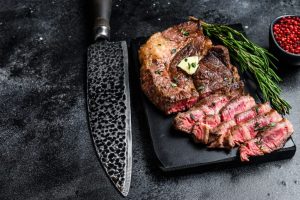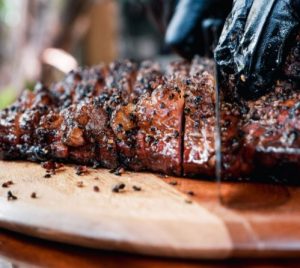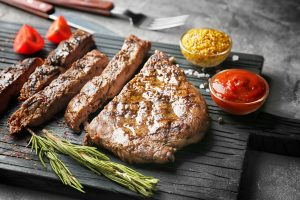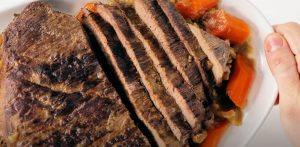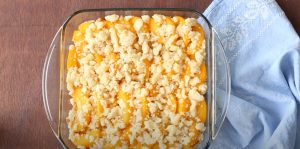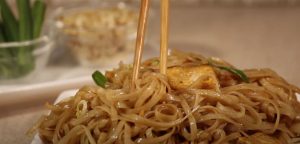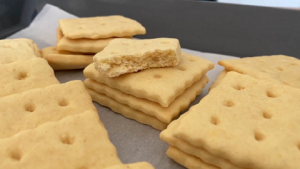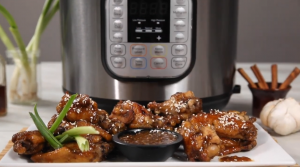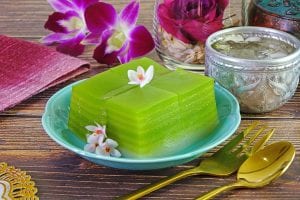A sous vide beef tenderloin offers unparalleled flavor and tenderness. This recipe creates a meal that is special enough for a dinner party, but simple enough for a no-fuss weeknight dinner. The sous vide method assures perfect doneness while the searing gives the beef a delicious crust. A tawny port wine sauce enhances the beef's natural flavors and takes the dish to a new level.
The ingredients for this recipe are fairly common, but one you might not have on hand is tawny port wine. This slightly sweet dessert wine is used to create a rich, flavorful sauce for the beef. If you can't find tawny port, you can substitute a ruby port or a red wine, but the flavor will be slightly different. Also, make sure you select a beef tenderloin cut - it's a prime piece of meat known for its tenderness and flavor.
Beef Tenderloin Sous Vide Recipe Ingredients
Beef tenderloin: This is a premium cut of beef, known for its tenderness and rich flavor. It's the star of this recipe.
Salt: Used to bring out the flavors of the beef.
Black pepper: Adds a bit of heat and complements the other flavors in the dish.
Vegetable oil: Used for searing the beef and creating a flavorful crust.
Butter: Adds richness and flavor to the sauce.
Tawny port wine: A sweet dessert wine that adds depth and sweetness to the sauce.
Garlic: A staple ingredient in many savory dishes, adding a punch of flavor.
Fresh thyme: This herb adds a subtle earthy flavor that complements the beef and sauce.
One reader, Anthiathia Cates says:





This sous vide beef tenderloin recipe is a game-changer! The meat was incredibly tender and juicy, and the flavors were out of this world. The cooking process was straightforward, and the end result was a restaurant-quality dish. I highly recommend trying this recipe for a special occasion or a fancy dinner at home.
How To Make Sous Vide Beef Tenderloin
This tender sous vide-cooked and generously-seasoned beef tenderloin is made extra flavorful with a marinade made of port wine, butter, thyme, and garlic!
Serves:
Ingredients
- 2lbsbeef tenderloin,center cut
- 1tspsalt
- freshly ground black pepper
- 2tbspvegetable oil,divided
- 2tbspbutter
- ½cuptawny port wine
- 5clovesmedium garlic
- 6sprigsfresh thyme,plus more to serve
Instructions
-
Sprinkle the tenderloin with salt and a generous amount of pepper.
-
Heat 1 tablespoon of oil in a 10-inch skillet over medium-high heat.
-
When the pan is hot enough, a drop of water should sizzle and quickly evaporate on contact.
-
Sear the tenderloin in the pan for 1 to 2 minutes on each side and both ends, until it’s dark brown all over.
-
Transfer to a plate or cutting board and allow to cool slightly.
-
While the pan is still hot, add the butter and garlic.
-
Cook for 30 to 60 seconds.until the garlic is golden and fragrant.
-
Add the port wine and use a stiff spatula to scrape up any browned bits from the bottom of the pan.
-
Let the wine come to a simmer, then remove from the heat.
-
Make sure the tenderloin and sauce are no longer steaming. It’s fine if still quite warm, but it can melt through the bag if still steaming hot.
-
Place a gallon-sized zip-top freezer bag on the counter and flip the zip-top edge outward, forming a cuff around the bag to help the bag stay open and upright while being filled.
-
Transfer the tenderloin to the bag and pour the sauce over top. Lay 5 or 6 sprigs of thyme over the top of the tenderloin
-
Fill a stockpot with 5 or 6 inches of water.
-
Slowly submerge the tenderloin in the water, using the hands to help push out all the air from the bag as you go. When the top of the bag is reached, zip it closed.
-
Lift the tenderloin out of the water and place it on a towel while you heat the water for the sous vide.
-
Place the Joule or other sous vide immersion circulator in the stockpot of water.
-
Set the sous vide immersion circulator to heat the water to 133 degrees F for rare beef, 140 degrees F for medium-rare, 149 degrees F for medium-well, or 167 degrees F for well-done.
-
When the water has heated to its required temperature, lower the tenderloin into the water so that it is entirely submerged. It’s okay if the top of the bag pokes out of the water as long as the tenderloin itself is submerged.
-
It’s okay if the top of the bag pokes out of the water as long as the tenderloin itself is submerged.
-
Cook for 2½ to 3 hours, but avoid cooking for much longer or the beef will start to get a little soft and mushy.
-
When the tenderloin is done, lift it from the water and place the bag on a kitchen towel.
-
Heat the remaining tablespoon of oil in the skillet over medium-high heat until a drop of water sizzles and evaporates on contact.
-
Use tongs to lift the roast from the bag and transfer it to the skillet. Be careful—it will sputter.
-
Sear for 30 to 60 seconds on all sides, until the outside is even more deeply browned and a crust has formed.
-
Transfer the tenderloin to a cutting board and rest for 5 to 10 minutes.
-
With the pan still over medium-high heat, pour in the sauce directly from the bag into the pan (discard the sprigs of thyme).
-
Simmer for about 1 minute and scrape up any browned bits stuck to the bottom of the pan.
-
Carefully transfer the sauce to a serving cup.
-
Cut through the twine and discard.
-
Slice the tenderloin either into thick “filet mignon” steaks (1steak per person) or into thinner “roast beef” slices (3 or 4 slices per person).
-
Serve immediately with the sauce.
Recipe Notes
- This recipe can be stretched if feeding a few more people, if serving the tenderloin with several other dishes on the table.
- When buying the tenderloin roast, make sure the butcher removes the silver skin. Also, ask them to truss the roast with twine, if preferred, instead of personally doing the step.
Nutrition
- Calories: 468.95kcal
- Fat: 35.62g
- Saturated Fat: 13.67g
- Trans Fat: 0.19g
- Monounsaturated Fat: 15.94g
- Polyunsaturated Fat: 2.00g
- Carbohydrates: 3.07g
- Fiber: 0.61g
- Sugar: 0.70g
- Protein: 30.41g
- Cholesterol: 138.69mg
- Sodium: 407.44mg
- Calcium: 58.84mg
- Potassium: 502.53mg
- Iron: 2.80mg
- Vitamin A: 39.66µg
- Vitamin C: 5.58mg
Pro Tip for Achieving the Perfect Sous Vide Beef Tenderloin
When searing your beef tenderloin, ensure your pan is hot enough to create a beautiful crust but not too hot that it burns the meat. A good way to test this is by adding a drop of water to the pan. If it sizzles and evaporates quickly, the pan is ready. This technique, known as the 'water droplet test', helps to achieve a perfect sear every time. Additionally, remember to let your meat rest after searing. This allows the juices to redistribute throughout the tenderloin, resulting in a more flavorful and juicy steak.
Time-Saving Tips for Preparing Sous Vide Beef Tenderloin
Prep ahead: Marinate the beef tenderloin in the sauce the night before and store it in the refrigerator. This will allow the flavors to meld and save you time on the day of cooking.
Use a vacuum sealer: Invest in a vacuum sealer to quickly and efficiently remove air from the bag before sous vide cooking. This will ensure a better seal and more even cooking.
Sear in advance: Sear the beef tenderloin a day before sous vide cooking and refrigerate. This will save time on the day of serving and still provide a delicious crust.
Organize your workspace: Before you start cooking, make sure all your ingredients and equipment are easily accessible. This will streamline the cooking process and save time.
Precut ingredients: Pre-measure and chop all the ingredients before you start cooking. This will save time and make the cooking process more efficient.
Use a sous vide machine: Invest in a sous vide machine to ensure precise and consistent cooking without the need for constant monitoring. This will save time and effort in the kitchen.
Opt for pre-sliced beef: Purchase pre-sliced beef tenderloin to save time on preparation. This will eliminate the need for trimming and slicing the meat yourself.
Minimize cleanup: Use disposable sous vide bags to minimize cleanup. This will save time and effort after cooking.
Prepare the serving sauce in advance: Make the sauce ahead of time and store it in the refrigerator. This will save time on the day of serving and allow the flavors to develop.
Substitute Ingredients For Sous Vide Beef Tenderloin Recipe
beef tenderloin - Substitute with pork tenderloin: Pork tenderloin is a lean and tender cut of meat that can be cooked sous vide to a similar level of tenderness as beef tenderloin. It has a slightly different flavor profile but works well with the given recipe.
tawny port wine - Substitute with red wine vinegar: Red wine vinegar can provide a similar depth of flavor and acidity to the dish as tawny port wine. It adds a tangy and rich taste to the beef tenderloin when used in the sous vide cooking process.
Presenting Your Perfectly Cooked Beef Tenderloin
Elevate the plating: When presenting the sous vide beef tenderloin, focus on creating an elegant and visually appealing presentation. Use clean lines and minimalistic plating to showcase the natural beauty of the dish.
Incorporate vibrant colors: Introduce vibrant and colorful elements to the plate to enhance the visual appeal. Consider using microgreens, edible flowers, or colorful vegetable purees to add pops of color to the dish.
Utilize negative space: Embrace the concept of negative space on the plate to allow the beef tenderloin to stand out. Avoid overcrowding the plate and allow the main components to take center stage.
Highlight the beef: Place the sliced beef tenderloin as the focal point of the dish. Arrange the slices in an artful manner to draw attention to the succulent texture and rich color of the meat.
Garnish with precision: Add delicate garnishes with precision, such as finely chopped herbs or edible gold leaf, to add a touch of sophistication to the presentation without overpowering the main dish.
Consider the plate shape and size: Choose the appropriate plate shape and size to complement the presentation. Opt for a plate that allows the beef tenderloin to be the star while providing ample space for artistic plating.
Balance flavors and textures: Incorporate complementary elements on the plate to balance flavors and textures. Pair the beef tenderloin with contrasting components, such as a velvety puree or a crisp tuile, to create a harmonious dining experience.
Emphasize the sauce: Showcase the accompanying sauce by drizzling it artfully around the plate or using a quenelle technique to create an eye-catching sauce presentation.
Add a finishing touch: Complete the presentation with a final touch, such as a sprinkle of sea salt or a drizzle of high-quality balsamic glaze, to add depth and complexity to the dish.
Essential Tools for Making Sous Vide Beef Tenderloin
- Sous vide immersion circulator: A device used to precisely control the temperature of the water for sous vide cooking.
- Skillet: A flat-bottomed pan used for searing and cooking the beef tenderloin.
- Zip-top freezer bag: A plastic bag with a sealable zip top, used for vacuum sealing the beef and sauce for sous vide cooking.
- Stockpot: A large pot used for heating water for the sous vide cooking process.
- Tongs: Used for lifting and transferring the beef tenderloin during the cooking process.
- Kitchen towel: A cloth towel used for drying and handling the sous vide-cooked beef tenderloin.
- Cutting board: A flat surface used for cutting and resting the cooked beef tenderloin.
- Serving cup: A container used for serving the sauce that accompanies the beef tenderloin.
- Twine: Used for tying the beef tenderloin to maintain its shape during cooking.
- Joule (sous vide immersion circulator brand): A specific brand of sous vide immersion circulator used for precise temperature control in sous vide cooking.
Storing and Freezing Your Sous Vide Beef Tenderloin
- Storing: If you have leftover beef tenderloin, allow it to cool completely before storing in an airtight container in the refrigerator for up to 3-4 days
- To reheat, simply slice the desired amount of beef and heat it in a skillet with a bit of butter or oil over medium heat until warmed through
- You can also reheat the slices in the microwave, but be careful not to overheat as it can quickly overcook the meat
- Freezing: To freeze the beef tenderloin, wrap it tightly in plastic wrap and then place it in a freezer-safe bag or container
- Squeeze out as much air as possible before sealing to prevent freezer burn
- Label the bag with the date and contents, and freeze for up to 2-3 months for best quality
- To thaw, transfer the frozen beef to the refrigerator and allow it to thaw overnight
- Once thawed, you can reheat the beef using the methods mentioned above, or slice it thinly and serve it cold in sandwiches or salads
- If you have any leftover sauce, store it in a separate airtight container in the refrigerator for up to 3-4 days
- Reheat the sauce in a small saucepan over low heat, stirring occasionally, until warmed through
How To Reheat Leftover Sous Vide Beef Tenderloin
To reheat leftover sous vide beef tenderloin, start by preheating your oven to 250°F (120°C). This low temperature will help to gently warm the meat without overcooking it.
While the oven is preheating, remove the leftover tenderloin from the refrigerator and let it sit at room temperature for about 15-20 minutes. This will help the meat to reheat more evenly.
Place the tenderloin on a baking sheet or in a shallow baking dish. If you have any leftover sauce or juices, pour them over the meat to help keep it moist during reheating.
Cover the baking sheet or dish with aluminum foil to prevent the meat from drying out. Place the covered tenderloin in the preheated oven.
Reheat the tenderloin for approximately 20-30 minutes, or until it reaches an internal temperature of 120°F (49°C) for rare, 125°F (52°C) for medium-rare, or 130°F (54°C) for medium. Use a meat thermometer to check the temperature.
If you prefer a crispier exterior, remove the foil during the last 5 minutes of reheating and increase the oven temperature to 400°F (200°C). This will help to brown and crisp the outside of the tenderloin.
Once the desired temperature is reached, remove the tenderloin from the oven and let it rest for 5-10 minutes before slicing and serving. This resting period allows the juices to redistribute throughout the meat, ensuring a more flavorful and tender result.
Alternatively, you can reheat individual slices of beef tenderloin in a skillet over medium heat. Add a small amount of butter or oil to the pan and cook the slices for 1-2 minutes on each side, or until they are heated through.
Interesting Trivia About Sous Vide Beef Tenderloin
The sous vide cooking method was originally developed in the 1970s by French and American engineers. It was initially used in industrial food production before gaining popularity in home kitchens. This precise and controlled cooking technique allows the beef tenderloin to cook evenly and retain its natural juices, resulting in a tender and flavorful dish.
Is Making Sous Vide Beef Tenderloin at Home Cost-Effective?
The cost-effectiveness of this sous vide beef tenderloin recipe largely depends on the price of the beef tenderloin and tawny port wine. While beef tenderloin can be on the pricier side, the sous vide method ensures a perfectly cooked, tender result. The use of butter and garlic adds richness and flavor. The approximate cost for a household of 4 people would be around $50-$60. Considering the quality of the dish and the experience of enjoying a restaurant-quality meal at home, this recipe rates a solid 8 out of 10 for its cost-effectiveness.
Is Sous Vide Beef Tenderloin Healthy or Unhealthy?
The sous vide beef tenderloin recipe is a delicious and indulgent dish, but it may not be the healthiest option due to several factors:
- High saturated fat content from the beef tenderloin and butter, which can contribute to heart disease and high cholesterol levels when consumed in excess.
- Added salt and lack of vegetables or fiber-rich ingredients, which can lead to an unbalanced meal.
- The use of port wine, while adding flavor, also increases the calorie content of the dish.
However, the sous vide cooking method itself is a healthier alternative to traditional high-heat cooking, as it helps retain nutrients and prevents the formation of harmful compounds.
To make this recipe healthier without compromising on taste, consider the following suggestions:
- Opt for a leaner cut of beef, such as sirloin or top round, to reduce the saturated fat content.
- Reduce the amount of butter used or replace it with heart-healthy olive oil.
- Incorporate more vegetables into the dish, such as roasted or sautéed mushrooms, onions, or asparagus, to increase fiber and nutrient intake.
- Serve the tenderloin with a side of leafy greens or a colorful salad to create a more balanced meal.
- Reduce the amount of added salt and rely on herbs and spices for flavor instead.
- Use a lower-calorie red wine or beef broth in place of the port wine to cut down on calories while still providing depth of flavor.
Editor's Take on This Delectable Sous Vide Recipe
The recipe for sous vide beef tenderloin is a classic and elegant dish that promises a tender and flavorful result. The method of searing the beef before sous vide cooking adds depth of flavor, while the tawny port wine and garlic sauce elevates the dish with rich and aromatic notes. The detailed instructions ensure a perfectly cooked and beautifully presented beef tenderloin, making it an impressive centerpiece for any special occasion. This recipe is a testament to the art of sous vide cooking and is sure to delight the senses with its exquisite taste and texture.
Enhance Your Sous Vide Beef Tenderloin Recipe with These Unique Side Dishes:
Similar Recipes to Try If You Love Sous Vide Beef Tenderloin
Appetizers and Desserts That Complement Sous Vide Beef Tenderloin
Why trust this Sous Vide Beef Tenderloin Recipe:
This recipe for sous vide beef tenderloin is a testament to precision cooking. The tenderloin is seasoned with salt and freshly ground black pepper, then seared to perfection for a rich, caramelized crust. The addition of tawny port wine and fresh thyme infuses the meat with deep, complex flavors. The sous vide method ensures precise temperature control, resulting in a perfectly cooked, tender beef tenderloin every time. Trust in the meticulous technique and exquisite combination of flavors to elevate your dining experience.
Was this page helpful?
Have your own special recipe to share? Submit Your Recipe Today!




